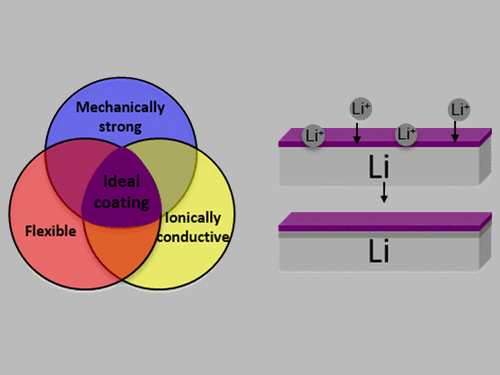
UT researchers are leading the development of a broad range of battery chemistries and materials to specifically address the needs of key industries, such as transportation and defense. Design criteria include increased gravimetric and volumetric energy density, reduced weight, increased cycle life, increased power, use of sustainable materials and a view toward U.S. energy independence.
Battery Types
Lithium-ion
Research Goals: Sustainability; Supply chain security; Increased energy density; Lower cost; Faster charging
Materials/Approaches Include: High-Ni, Co-free cathodes; Silicon nanorods; Nanocomposite foil anodes
Sodium-ion, Potassium-ion
Research Goals: Improved cycle life
Materials/Approaches Include: Design of new cathode materials (e.g. layered oxide, polyanionic); Design of new anode materials (e.g. crumbled graphene)
Multivalent-ion (e.g. Mg, Zn, Ca, Al ions)
Research Goals: Faster kinetics
Materials/Approaches Include: Development of electrode hosts and electrolyte systems; Full system designs for aqueous-based systems
Metal-sulfur (Li and Na)
Research Goals: Improved cycle life and increased energy density
Materials/Approaches Include: Control of the polysulfide shuttle (e.g. membranes, catalysts for lithium polysulfide conversion); Reduced formation of polysulfides (e.g new cathode materials, in situ cathode formation)
Lithium-metal, Sodium-metal, Potassium-metal
Research Goals: Improved cycle life
Materials/Approaches Include: SEI stabilization strategies; New cathode materials (e.g. selenium-sulfur); Prevention of dendrite formation (e.g. electrolyte wetting, artificial coatings); Liquid metal (e.g. alloys, interfacial engineering and design of electrolytes)
Solid-state
Research Goals: Faster kinetics
Materials/Approaches Include: Polymer electrolyte design - beyond PEO; Ceramic electrolyte; Ceramic-composite electrolytes
Redox Flow (aqueous and non-aqueous)
Research Goals: Improved cycle life for current chemistries; New, more efficient chemistries for high-energy storage systems
Materials/Approaches Include: Solid-electrolyte separators to eliminate chemical crossover; Conductive and stable membrane design; High capacity, abundant electrolytes (e.g. azobenzene-based); High-energy-density organic eutectic electrolytes
Faculty In This Area
Michael Aubrey
Emma Fan
John Goodenough
Hadi Khani
Brian Korgel
Nathaniel Lynd
Arumugam Manthiram
David Mitlin
Buddie Mullins
Venkat Subramanian
Guihua Yu
Recent Research Projects
Nano-scale Approach for Binder-free Li-S Batteries
Emma Fan
Electrochimica Acta
A Self-Regulated Gradient Interphase for Dendrite-free Solid-State Li Batteries
John Goodenough
Energy & Environmental Science
Designing Composite Polymer Electrolytes for All-Solid-State Batteries
John Goodenough and Hadi Khani
Current Opinion in Electrochemistry
Technological Pathways toward Sustainable Batteries
Arumugam Manthiram
One Earth
Stable Cycling of Potassium Metal Anodes and of Potassium Metal Batteries
David Mitlin
Advanced Materials
Transition Metal-doped Ni-rich Layered Cathode Materials for Durable Li-ion Batteries
Buddie Mullins
Nature Communications
Dual-Ion Flux Management for Stable Lithium–Sulfur Batteries
Guihua Yu
Advanced Energy Materials

